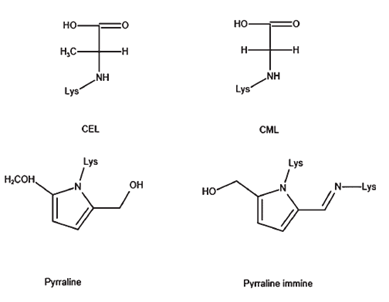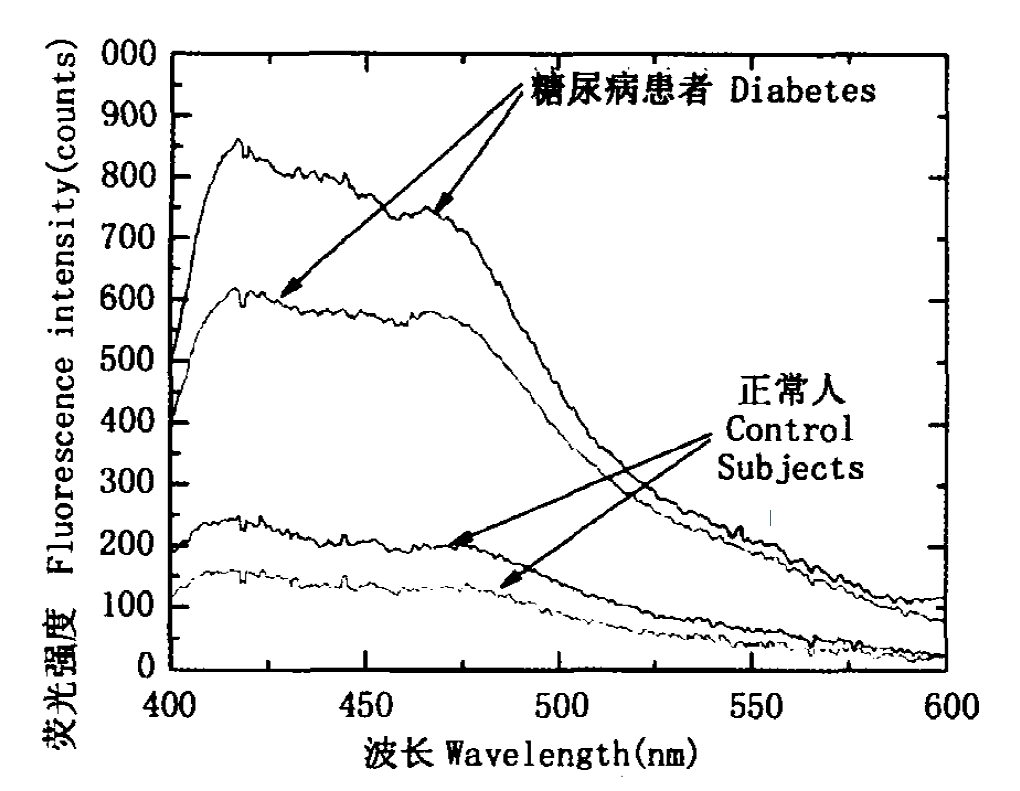|
簡體中文|
English| Launch:2022-05-26 |
abstract
Fl375 is an integrated small fluorescence spectrometer, which is used to detect the content of Advanced Glycation End-products (AGEs) in skin. It is equipped with 45 / 0 optical path design and MEMS spectrometer, with small volume and high sensitivity. Built in filter can filter out the interference of excitation light. The post spectroscopic technology is adopted, and the spectrum is stable and reliable.
Source of advanced glycation end products
Advanced glycation end products (AGEs) are formed by the affinity addition reaction between the terminal amino group of macromolecular substances (such as proteins, lipids and nucleic acids) and the carbonyl group of reducing sugars (such as glucose, pentose and xylose) under non enzymatic conditions to produce reversible Schiff bases. The Schiff bases undergo Amadori rearrangement to produce stable aldehyde amines. Aldehyde amines undergo a series of dehydrogenation Oxidation and rearrangement reactions produce carbonyl compounds. Highly active carbonyl compounds react with functional groups such as free radicals and sulfhydryl groups of proteins to denature them and produce stable AGEs [1].
AGEs can be classified into endogenous AGEs and exogenous AGEs according to their sources. Endogenous AGEs are mainly produced by the Maillard reaction of macromolecular substances in the body, and exogenous AGEs are mainly derived from foods with high fat and protein and fried with high heat. At present, common AGEs include carboxymethyl lysine (CML), carboxyethyl lysine (CEL), pentosidine, glyoxal lysine dimer (gold), pyrroline, etc. [2].

Figure 1 structural formula of common AGEs
Hazards of advanced glycation end products
AGEs is brownish red and not easy to be destroyed by enzymes. It can gradually accumulate in the human body and combine with many cell membrane specific receptors to exert biological effects. The accumulation of AGEs in the body will cause a series of oxidative stress cascade and inflammatory reactions, thus accelerating the aging of the human body and the occurrence and development of various diseases, such as diabetes and its complications, Alzheimer's disease, intestinal diseases, neurological diseases, cancer, etc. [2]. Yangsanmei et al. [3] studied that the fluorescence spectrum types of diabetes patients and normal people are basically the same, but in the whole measurement spectrum range, the fluorescence spectrum intensity of diabetes patients is significantly higher than that of normal people. Obayashi h[4] detected AGEs in coronary atherosclerotic lesions of diabetes patients, confirming that AGEs may lead to atherosclerosis in diabetes patients. The increase of serum AGEs level in diabetes patients will accelerate the development and progress of heart failure indirectly through its vascular effect (coronary artery dysfunction, atherosclerosis and thrombosis) and directly through its direct effect on myocardium [5].

Fig. 2 fluorescence spectra of AGEs in patients with diabetes and normal subjects
Detection of advanced glycation end products
The basic principle of fl375 is to use the safe light source led375 nm to excite the fluorescent AGEs of human skin, and reflect the accumulation of AGEs according to the obtained optical signal. The method of detecting AGEs content by fluorescence spectrum is very fast, convenient and reproducible. There is no need to collect blood samples. It is a non-invasive spectral detection technology. Compared with blood sampling for biochemical experiments, patients are more likely to accept the pain and infection that may be brought to patients. The fluorescence spectrum of skin measured by fl375 is processed by algorithm to obtain AF value. The AF value indicates that the accumulation of AGEs in the body is calculated by automatically absorbing the fluorescence emitted by AGEs in human tissue. The larger the value, the higher the accumulation. The subjects can make early prediction and diagnosis of their physical condition (including whether they may have diabetes, physical aging, etc.) according to the test data.

Fig. 3 fluorescence spectrum of AGEs measured by fl375 in normal people
Product recommendation:
Fl375 is an integrated small fluorescence spectrometer, which is used to detect the content of advanced glycation end products (AGEs) in skin. It is equipped with 45 / 0 optical path design and MEMS spectrometer, with small volume and high sensitivity. Built in filter can filter out the interference of excitation light. The post spectroscopic technology is adopted, and the spectrum is stable and reliable.
The skin fluorescence spectrum measured by fl375 is processed by algorithm to display the skin fluorescence value (AF). The AF value indicates that the accumulation of AGEs in the body is calculated by automatically absorbing the fluorescence emitted by AGEs in human tissue. The larger the value, the higher the accumulation. The subjects can make early prediction and diagnosis of their physical condition (including whether they may have diabetes, physical aging, etc.) according to the test data.
The accumulation of AGEs in the body will cause a series of oxidative stress cascade and inflammatory reactions, thus accelerating the aging of the human body and the occurrence and development of various diseases, such as diabetes and its complications, Alzheimer's disease, intestinal diseases, neurological diseases, cancer, etc.
Product features:
![]() Small size
Small size
![]() high sensitivity
high sensitivity
![]() 45 / 0 optical path design
45 / 0 optical path design
Product parameters:
Product model | FL375 |
Led wavelength | 375 nm |
Led linewidth | 10 nm |
Optical path design | 45/0 |
Measurement window | Φ 10 mm |
Spectral range | 400-700 nm |
spectral resolution | 10 nm |
working temperature | 5-80℃ |
Working humidity | 5%-80% |
Reference:
[1] Zhou Yanqiong, Jin Cheng, Zhang Ying Research Progress on formation pathway, detection methods and inhibition methods of advanced glycation end products (AGEs) [J] Chinese Journal of food, 2013, 13 (6): 175-184
[2] Xu Zhenghua, Liang Yushen, Zhu Kewei, etc Research progress of intermediate and end products of advanced glycosylation in food [J] Journal of food safety and quality inspection, 2020, 11 (5): 1496-1501
[3] Yang Sanmei, Yu Feng, Wang Yikun, Zhang long, Zhu Ling, Zhang Gong, Liu Yong, Wang An Application of advanced glycation end products fluorescence spectrometry in screening of diabetes [j] Acta biologica Sinica, 2011,01-129
[4] Obayashi H, Nakano K, Shigeta H, et al. Formation of cross line as a fluorescent advanced glycation end product in vitro and in vivo[J]. Biochemical and Biophysical Research Communications, 1996, 226:37-41.
[5] Dorien D, Lize E, Virginie B. Advanced glycation end products (AGEs) and cardiovascular dysfunction: focus on high molecular weight AGEs[J]. Amino Acids, 2017, 49(9):1535-1541.

